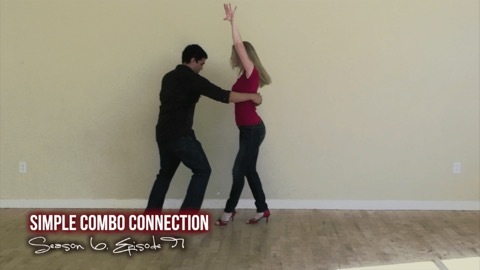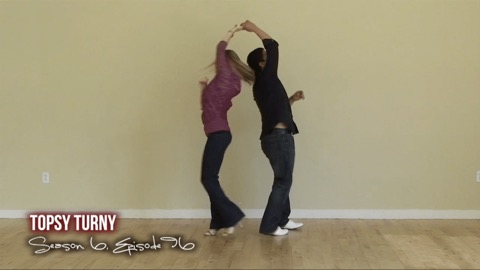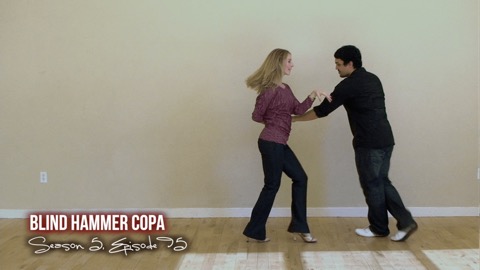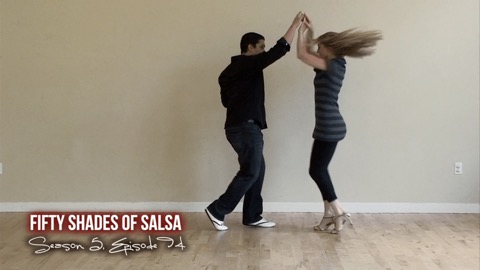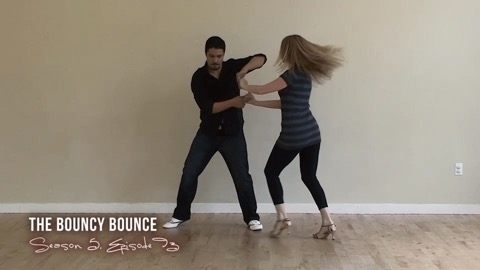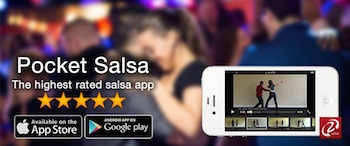Review of Salsa Dance Shoes for Men
In the large spectrum of dance shoes, there is very little written about the variety of options available to men. Now that I have gone through enough salsa dance shoe phases, it is time to provide my experience and mini-reviews of the dance shoes I have worn throughout my salsa lifetime.
If you have been a long time fan of the addicted2salsa podcast, you may have noticed the original shoes that I wore for the series. Those days are gone, and so are those shoes that were given the famous name, 'salsa boots'. Here I present an overview of my dance shoe evolution throughout different stages of my salsa life. While I know beginners are sometimes preoccupied with having a good set of dance shoes since they will help their 'salsa game' - most of these shoes only add an incremental amount of performance enhancement compared to proper training and execution of footwork and patterns. Shoes are no replacement for real salsa dance practice.
This is the list of shoes I will be comparing in order of how I bought and used them: The Street Shoes, The Bloch Sneakers, The Jazz Shoes, The Latin Ballroom Shoes, The Practice Sneakers, The "Pointy" Shoes, The Modern Suede Shoe (my favorite)
The Street Shoes
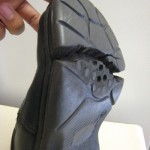
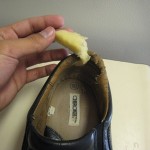 After so many comments in regards to my bulky shoes, you may have asked yourself, why did I even decide to change those awesome shoes! (sarcasm)
After so many comments in regards to my bulky shoes, you may have asked yourself, why did I even decide to change those awesome shoes! (sarcasm)
The picture can a explain a bit of why those boots weren't meant for dancing. The shoes were a good starter for people not thinking about salsa is a long commitment, since you can wear these shoes in other contexts than dancing. This made it also easy to attend salsa clubs that required a good walk or dance clubs where there was not actual dance floor.
I was very impressed that they lasted for several years since I used them to attend school in addition to salsa classes before they broke down. After that severe rip (show above), I realized that I should invest in proper dance shoes.
| Attributes | |
|---|---|
| Price Est. | $10-$20 |
| Style Factor | Low |
| Weight | Heavy |
The Good
Great for beginners since it requires a minimum investment and can be used for other non-salsa occasions. The thick rubber sole is good to wear and tear on any non-wood floor without worrying about damage. You also don't have to worry about getting them wet.
The Bad
Hard on the feet due to thickness. Don't expect to do proper footwork and have a lot of maneuverability. Not very flexible and can easily break over long periods of stress.
The Bloch Sneakers
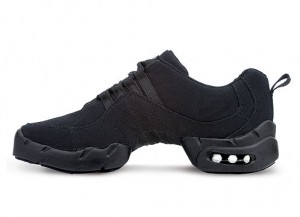 The next set of popular beginner footwear in my life ended up being the Bloch (brand) sneaker. They tend to be a mix between a nifty sneaker with rubber bottom and split-shoe. They are definitely more comfortable than a street shoe for dancing due to the soft sneaker-like padding.
The next set of popular beginner footwear in my life ended up being the Bloch (brand) sneaker. They tend to be a mix between a nifty sneaker with rubber bottom and split-shoe. They are definitely more comfortable than a street shoe for dancing due to the soft sneaker-like padding.
In my personal salsa evolution, I wore these for about 1 year for going to lessons and dance practice. They are much lighter than the street shoe and provide much better support in the arch area. This extra support allows you to dance for much longer periods of time while adding more stability to feet when planted. The "key" there is the word planted. I did notice that I had a hard time executing turns and footwork shines when wearing these shoes. After a thorough review of my "Physics 221" and "Kinematics for Salseros" books, I realized the following issues:
-
The additional height between the floor and your foot affects the center of gravity when learning to spin. This is analogous to how differently a sharp turn affects a tall JEEP (tall heavy) in comparison to a Ferrari (bottom heavy).
-
The split-shoe design allows you to more easily move your weight to either the ball of the foot or the heel. While this may not seem like a bad issue, it affects how you spin if you have not yet mastered spinning perfectly on the balls of your feet. When learning to spin, you may tilt forward or back as you learn about your own center of gravity. Because these shoes do not have a full bottom frame, your weight can only be in the front or the heel, so it may present challenges until you master spinning on the balls of your feet.
-
The rubber on the bottom adds too much friction.
-
Trying multiple spins with these shoes is like polishing jello with sandpaper.
| Attributes | |
|---|---|
| Price Est. | $40-$50 |
| Style Factor | Very Low |
| Weight | Medium |
The Good
Great for the push-like arch support thanks to the split-shoe-like form. A good replacement for a torn up street shoe that allows for prolonged dancing.
The Bad
If you are a beginner trying to improve your spins or footwork, this shoe is not for you. You can't change the laws of physics. I don't plan on returning to these shoes anytime soon.
The Jazz Shoes
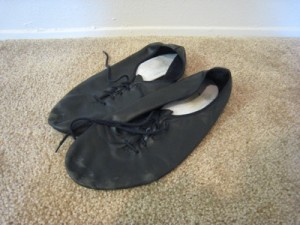 When professional dancers state that dance shoes should fit like a 'glove', it doesn't get closer than jazz shoes.
When professional dancers state that dance shoes should fit like a 'glove', it doesn't get closer than jazz shoes.
While jazz shoes tend to be used for other dances, many salseros have used jazz shoes for their lessons and social dancing. They are extremely light since they are like a sock for your feet. You will feel much more grounded since your feet will feel as if they have direct contact with the floor. Most of them have suede bottoms, which allow you to perform footwork and spins a lot easier on proper dance floors. These types of shoes are the ones I would recommend for beginner to intermediate salsa dancers. They are affordable, easy to carry around and can be treated as disposable shoes if they become too worn out since they are relatively cheap. It is a great dance shoe for salsa practice and attending lessons and they tend to last from 6 months to 1 year.
However, this shoe has its limitations when it comes to social dancing. Since the shoes fit like a 'glove', they provide no protection for your toes against a devastating attack from women with unstable high-heels or from unstable women with high-heels. Second, there is no support for your foot at all. Generally individuals with flat feet (no arch), such as myself, tend to get tired dancing much quicker in these shoes. There is a minor maintenance cost of making sure you brush the suede every now and then to keep them from being to slippery - however this is true for all suede bottom shoes.
You can get these shoes at any regular dance shoe store.
| Attributes | |
|---|---|
| Price Est. | $20-$40 |
| Style Factor | Very Low |
| Weight | Very Light |
The Good
Great for beginners and newly intermediates. Best for salsa practice and light dance socials where you have a proper dance floor. Highly portable design.
The Bad
No protection for the feet, which may cause additional injuries. You need to carry them into the salsa club before putting them on (not for street walking).
The Latin Ballroom Shoe
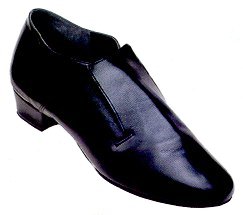 A very popular shoe for professionals, especially on International Latin Ballroom competitions and salsa dance performances. These shoes are basically a dress shoe that is very lightweight with a suede bottom. Most of them follow a split-shoe pattern, which allows for a flexible area between the elevated heel and the ball of your foot. One of the benefits of this shoe is that the elevated heel forces your weight diagonally downward towards the ball of your foot - which is where your weight should be when dancing.
A very popular shoe for professionals, especially on International Latin Ballroom competitions and salsa dance performances. These shoes are basically a dress shoe that is very lightweight with a suede bottom. Most of them follow a split-shoe pattern, which allows for a flexible area between the elevated heel and the ball of your foot. One of the benefits of this shoe is that the elevated heel forces your weight diagonally downward towards the ball of your foot - which is where your weight should be when dancing.
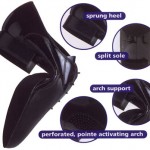
However, this heel also presents problems of its own when applied to salsa dancing. The heel is a hard solid piece and therefore does not provide enough friction to use it as a salsa handbrake (not that this is good technique). Additionally, any footwork shines that you'd like to perform that utilize the heel will not feel as comfortable as other shoes. In some instances, these shoes come in split-shoe pattern, similar to Bloch sneakers. This means there is no solid framework or foundation for your foot near the arch, which may make some dancers feel more unstable than in other shoes.
| Attributes | |
|---|---|
| Price Est. | $70-$120 |
| Style Factor | High |
| Weight | Light |
The Good
Best for dance performances and competitions when the attire calls for it and the proper dance floor is available.
The Bad
The heel might become an obstacle to some dancers (most Latin heels are 1.5 inches). Not suitable for rough salsa dance environments.
The Practice Sneaker
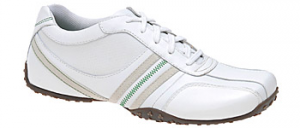 These are a new breed of salsa dance sneaker that mixes the look and feel of a regular walking shoe with some elements of a light dance shoe. These we generally designed for more of the swing dance crowd first, before they started to be used in salsa dancing. Some designs come with a thin suede bottom and others have a very prickly-plastic texture that allows for reduced friction. They are quality shoes that you will enjoy dancing with during salsa lessons and dance practice. The only issue is that if you choose the more non-suede bottom version, the sole will wear out faster over time which might increase the replacement cycle. Also, given your fashion sense when dancing at a club or at a salsa congress, sneakers might not be a good option. If you are interested in these shoes, you can check out Aris Allen (swing), Puma or Aldo's.
These are a new breed of salsa dance sneaker that mixes the look and feel of a regular walking shoe with some elements of a light dance shoe. These we generally designed for more of the swing dance crowd first, before they started to be used in salsa dancing. Some designs come with a thin suede bottom and others have a very prickly-plastic texture that allows for reduced friction. They are quality shoes that you will enjoy dancing with during salsa lessons and dance practice. The only issue is that if you choose the more non-suede bottom version, the sole will wear out faster over time which might increase the replacement cycle. Also, given your fashion sense when dancing at a club or at a salsa congress, sneakers might not be a good option. If you are interested in these shoes, you can check out Aris Allen (swing), Puma or Aldo's.
| Attributes | |
|---|---|
| Price Est. | $80-$120 |
| Style Factor | Medium |
| Weight | Light to Medium |
The Good
This is probably the best practice shoe for beginners and intermediates.
The Bad
Hard on the feet due to thickness. Don't expect to do proper footwork and have a lot of maneuverability. Not very flexible and can easily break over long periods of stress.
The "Pointy" Shoes
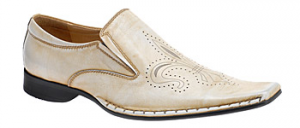 If you are from the Los Angeles, California salsa dance scene (or similar), you will easily recognize these types of shoes. They tend to be the most popular shoes for showy salsero dancers at salsa congresses since they match a variety of clothing styles and sunglasses. They can come in the form of either "pointy" dress shoes or cowboy-looking boots with leather (or plastic leather) top and a full length wood-like bottom finish. These were never designed for dancing purposes, but they work well on wooden dance floors thanks to their wood-like finish on the bottom. The heel is rubber, which works as a salsa handbrake when spinning. The front part of the shoe is angled upwards, which focuses the ball of your foot to be the main contact point on the floor. However, one of the downsides of these shoes is that it makes it harder to perform complicated footwork movements due to the long length of the shoe and its outward rim. I would only recommend these shoes to high level intermediate to advanced dancers since it requires a steep learning curve when applied to salsa dancing.
If you are from the Los Angeles, California salsa dance scene (or similar), you will easily recognize these types of shoes. They tend to be the most popular shoes for showy salsero dancers at salsa congresses since they match a variety of clothing styles and sunglasses. They can come in the form of either "pointy" dress shoes or cowboy-looking boots with leather (or plastic leather) top and a full length wood-like bottom finish. These were never designed for dancing purposes, but they work well on wooden dance floors thanks to their wood-like finish on the bottom. The heel is rubber, which works as a salsa handbrake when spinning. The front part of the shoe is angled upwards, which focuses the ball of your foot to be the main contact point on the floor. However, one of the downsides of these shoes is that it makes it harder to perform complicated footwork movements due to the long length of the shoe and its outward rim. I would only recommend these shoes to high level intermediate to advanced dancers since it requires a steep learning curve when applied to salsa dancing.
Additionally, dancing several dances in a row (with no breaks) will tire your feet out very fast. If you enjoy the look and don't mind the feel, you can buy these types of shoes at Aldo's, Gabellini's (a previous Sponsor) or even Macy's. Just make sure you look for the characteristics: upward front arc, hard wood-like bottom finish and very thin (to none) outward rim.
| Attributes | |
|---|---|
| Price Est. | $80-$120 |
| Style Factor | High |
| Weight | Medium |
The Good
Excellent style and the wood-like finish on the bottom are good for spinning. They require very little maintenance and function as street shoes.
The Bad
Extremely hard to perform complicated footwork in these shoes. The wood-like finish on the bottom wears out quickly. May tire your feet out faster due to the form factor.
The Modern Suede Shoe
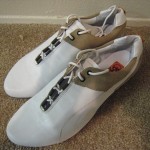 These are by far the latest in modern salsa shoe design and are by far the most carefully crafted dance shoes I have ever worn. They are very light, highly comfortable to wear and provide support around your foot compared to other Latin dance shoes. They are very elegant, with a nice smooth design which allows them to go great with many types of club-style clothing.
These are by far the latest in modern salsa shoe design and are by far the most carefully crafted dance shoes I have ever worn. They are very light, highly comfortable to wear and provide support around your foot compared to other Latin dance shoes. They are very elegant, with a nice smooth design which allows them to go great with many types of club-style clothing.
Why do I constantly recommend these shoes above many others? As an engineer, I admire designs that have been carefully thought out. The most important benefit of this shoe is in its sole design.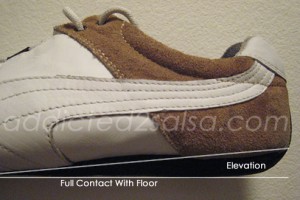 As you can see in the picture , the shoe is a mix of a platform-like shoe combined with the benefits of a jazz shoe with a forward looking sense of fashion. The addition of the wedge suede sole allows your weight to move forward to the ball of your feet while still allowing you to have full contact on the dance floor. This design allows for your weight to rest on the balls of your feet while allowing your center of gravity to be directly under your arch. There are a few drawbacks as with any other pair of dance shoes. Like all other suede-bottom shoes, the soles need to be brushed every so often to keep them in pristine shape.
As you can see in the picture , the shoe is a mix of a platform-like shoe combined with the benefits of a jazz shoe with a forward looking sense of fashion. The addition of the wedge suede sole allows your weight to move forward to the ball of your feet while still allowing you to have full contact on the dance floor. This design allows for your weight to rest on the balls of your feet while allowing your center of gravity to be directly under your arch. There are a few drawbacks as with any other pair of dance shoes. Like all other suede-bottom shoes, the soles need to be brushed every so often to keep them in pristine shape.
Given the benefit of them being light shoes, they may not be enough standard cushioning inside of the shoe for some dancers, however, this can be remedied by adding some additional massaging gel inserts. I am often asked what pair of men's dance shoes I would recommend for any dance level, and this is the one.
| Attributes | |
|---|---|
| Price Est. | $90-120 |
| Style Factor | High |
| Weight | Light |
The Good
Great combination of support, flexibility and weight. Perfect for improving your spins and footwork thanks to the wedge sole design. Allows for the perfect placement of your center of gravity.
The Bad
Not suitable for street walking due to the thin suede bottom and less portable than jazz shoes. Not enough standard cushioning inside of the shoe for long periods of dancing.
The Color of Footwork
While your fashion will most likely set a tone for the color of dance shoes you wear, you may want to consider an additional point: white shoes are best when your footwork is precise and attractive since the color will lure viewers to watch your feet compared to darker colored shoes. This is because the human eye has more appeal to brighter colors in motion than darker ones (highlights vs. shades). Lighter colors also provide a greater contrast from typically dark clubs.
Full disclosure: Gabellini Dance Shoes was a previous sponsor for our Addicted2Salsa podcast. Saying that, they are our sponsors because I love their product and I would never let anyone be a sponsor to Addicted2Salsa unless I loved their product.


